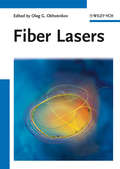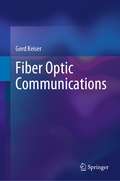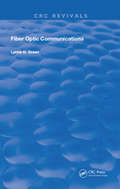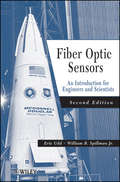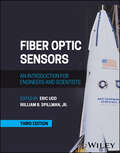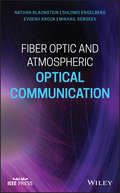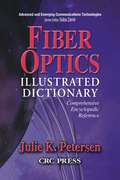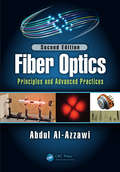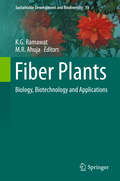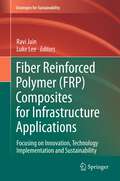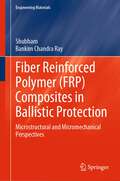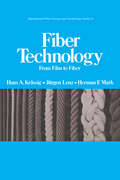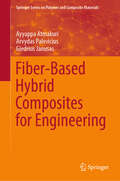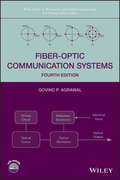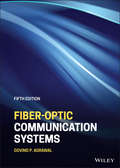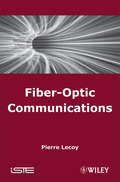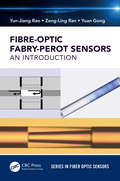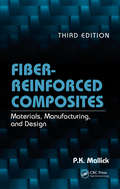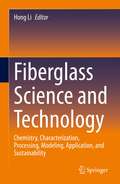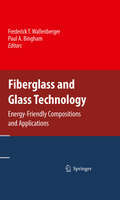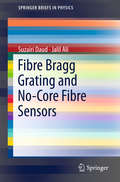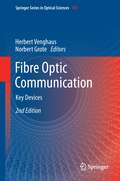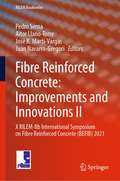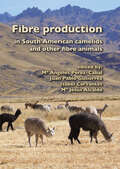- Table View
- List View
Fiber Lasers
by Oleg G. OkhotnikovA comprehensive account of the latest developments and applications in this rapidly developing field, covering a wide range of topics, such as power scaling and short pulse generation, dispersion management and modeling, broadband supercontinuum generation and wavelength tailoring.The book brings together contributions from the world's leading experts at major collaborative research centers throughout Europe, Australia, Russia and the USA. Each chapter presents a tutorial style introduction to the selected topic suitable for scientists, researchers and experts, as well as graduate and postgraduate students with a basic background in optics.
Fiber Optic Communications
by Gerd KeiserThis book highlights the fundamental principles of optical fiber technology required for understanding modern high-capacity lightwave telecom networks. Such networks have become an indispensable part of society with applications ranging from simple web browsing to critical healthcare diagnosis and cloud computing. Since users expect these services to always be available, careful engineering is required in all technologies ranging from component development to network operations. To achieve this understanding, this book first presents a comprehensive treatment of various optical fiber structures and diverse photonic components used in optical fiber networks. Following this discussion are the fundamental design principles of digital and analog optical fiber transmission links. The concluding chapters present the architectures and performance characteristics of optical networks.
Fiber Optic Communications (Routledge Revivals)
by Lynne D. GreenFirst published in 1993: This book is an outgrowth of fiber optic design courses given by the author.
Fiber Optic Sensors
by Eric Udd William B. Spillman Jr.Since the technology has moved strongly into a number of different areas a textbook of this sort could be used by a wide variety of academic departments including physics, electrical engineering, mechanical engineering, civil engineering, aerospace engineering and bioengineering. To make the second edition as widely appealing as possible a series of significant upgrades were made.1. The book is structured to support a variety of academic programs and it can also be used as a general reference by practicing engineers and scientists.2. The introductory chapter has been revised to outline the new content of the second edition and provide a overview of the current status of fiber optic sensor technology.3. A new, extensive chapter has been added covering fiber optic grating sensor technology and its application to aerospace, civil structures, oil and gas and power generating applications.4. A second new chapter has been added on the emerging field of biomedical fiber optic sensors. This is one of the most rapidly growing fields of use for fiber optic sensors and with rising health costs and medical advances promises to be an important area for many years to come.
Fiber Optic Sensors (Optical Science and Engineering)
by Shizhuo Yin Paul B. Ruffin Francis T. S. YuThe need for both intrinsic and extrinsic fiber optic sensor technologies continues to grow. To meet the demands of this fast expanding applications-driven market, Fiber Optic Sensors, Second Edition presents both the latest advances in fiber optic sensor technology, such as the application of photonic crystal fibers to fiber optic gyroscopes, and recent application opportunities, including the use of fiber optic sensors as a minimally invasive medical treatment. The new edition of this seminal work highlights the development of fiber optic sensors, while providing an overview of current methods for the construction of high-speed and high-capacity fiber optic systems. Two new chapters cover topics such as femtosecond laser illumination inscription and the growing application sector of fiber optic chemical and biological sensors. Adding significant new material, the book continues to provide a progressive history of each sensor type as well as basic principles and fundamental building blocks for practical applications in the electrical aerospace, defense and manufacturing, smart structure, undersea surveillance, medical, and gas and oil industries.
Fiber Optic Sensors: An Introduction for Engineers and Scientists
by Eric Udd William B. SpillmanFIBER OPTIC SENSORS Discover the latest in fiber optic sensors and their applications in this new edition Fiber-optic sensors are a powerful class of sensor that uses high-bandwidth optical fibers to convey a large amount of measured information through a single fiber. The advantages of such a mode of measurement are clear: they are intrinsically safe in explosive environments (no sparks), lightweight, compact, robust, and potentially inexpensive. As a result, their uses are manifold for a wide range of physical and chemical phenomena including temperature, strain, pressure, acoustic fields, position, velocity, rotation, acceleration, electrical current, liquid level, biochemical composition, and chemical concentration. Fiber Optic Sensors introduces and familiarizes the reader with a broad range of fiber optic sensor techniques and applications. The latest edition of this popular text builds upon the sound introductions to the fundamentals of the topic provided by earlier editions by introducing the latest technologies that have been developed in recent years. Gathering the latest research and publications on the subject in one place, the book provides a comprehensive look at fiber optic sensors with an eye to what’s new in the field. Readers of Fiber Optic Sensors’ third edition will also find: An exploration of the technology within new applications in areas such as aerospace, defense, oil and gas, medical, electric power, manufacturing, environmental, and robotics Updated chapters on the emergency of interferometric sensors, distributed sensing, and critical components A new and fully-updated comprehensive index Fiber Optic Sensors is a useful reference for engineers, scientists, technical managers, as well as advanced undergraduate and graduate students.
Fiber Optic and Atmospheric Optical Communication (Wiley - IEEE)
by Evgenii Krouk Nathan Blaunstein Shlomo Engelberg Mikhail SergeevA GUIDE TO THE FUNDAMENTAL THEORY AND PRACTICE OF OPTICAL COMMUNICATION Fiber Optic and Atmospheric Optical Communication offers a much needed guide to characterizing and overcoming the drawbacks associated with optical communication links that suffer from various types of fading when optical signals with information traverse these wireless (atmospheric) or wired (fiber optic) channels. The authors—noted experts on the topic—present material that aids in predicting the capacity, data rate, spectral efficiency, and bit-error-rate associated with a channel that experiences fading. They review modulation techniques and methods of coding and decoding that are useful when implementing communications systems. The book also discusses how to model the channels, including treating distortion due to the various fading phenomena. Light waves and their similarity to radio waves are explored, and the way light propagates through the atmosphere, through materials, and through the boundary between two materials is explained. This important book: Characterizes principal optical sources and detectors, including descriptions of their advantages and disadvantages, to show how to design systems from start to finish Provides a new method of predicting and dealing with the dispersive properties of fiber optic cables and other optical guiding structures in order to increase data stream capacity Highlights effects of material and multimode (multi-ray) dispersion during propagation of optical signals with data through fiber optic channels Presents modulation techniques and methods of coding and decoding that are useful when implementing communications systems Written for professionals dealing with optical and electro-optical communications, Fiber Optic and Atmospheric Optical Communication explores the theory and practice of optical communication both when the optical signal is propagating through the atmosphere and when it is propagating through an optical fiber.
Fiber Optics Illustrated Dictionary (Advanced & Emerging Communications Technologies)
by J.K. PetersenWithin a few short years, fiber optics has skyrocketed from an interesting laboratory experiment to a billion-dollar industry. But with such meteoric growth and recent, exciting advances, even references published less than five years ago are already out of date.The Fiber Optics Illustrated Dictionary fills a gap in the literature by providing instructors, hobbyists, and top-level engineers with an accessible, current reference. From the author of the best-selling Telecommunications Illustrated Dictionary, this comprehensive reference includes fundamental physics, basic technical information for fiber splicing, installation, maintenance, and repair, and follow-up information for communications and other professionals using fiber optic components. Well-balanced, well-researched, and extensively cross-referenced, it also includes hundreds of photographs, charts, and diagrams that clarify the more complex ideas and put simpler ideas into their applications context.Fiber optics is a vibrant field, not just in terms of its growth and increasing sophistication, but also in terms of the people, places, and details that make up this challenging and rewarding industry. In addition to furnishing an authoritative, up-to-date resource for relevant industry definitions, this dictionary introduces many exciting recent applications as well as hinting at emerging future technologies.
Fiber Optics: Principles and Advanced Practices, Second Edition
by Abdul Al-AzzawiThis book provides a step-by-step discussion through each topic of fiber optics. Each chapter explores theoretical concepts of principles and then applies them by using experimental cases with numerous illustrations. The book works systematically through fiber optic cables, advanced fiber optic cables, light attenuation in optical components, fiber optic cable types and installations, fiber optic connectors, passive fiber optic devices, wavelength division multiplexing, optical amplifiers, optical receivers, opto-mechanical switches, and optical fiber communications. It includes important chapters in fiber optic lighting, fiber optics testing, and laboratory safety.
Fiber Plants
by M. R. Ahuja K. G. RamawatThis book assesses the potential effects of biotechnological approaches, particularly genetic modification, on the present state of fiber crop cultivation and sustainable production. Leading international researchers discuss and explain how biotechnology can affect and solve problems in connection with fiber crops. The topics covered include biology, biotechnology, genomics and applications of fiber crops like cotton, flax, jute and bamboo. Providing complete, comprehensive and broad subject-based reviews, the book offers a valuable resource for students, teachers, and researchers including agriculturists, biotechnologists and botanists, as well as industrialists and government agencies involved in the planning of fiber crop cultivation.
Fiber Reinforced Polymer (FRP) Composites for Infrastructure Applications
by Ravi Jain Luke LeeThis book examines current issues of fiber reinforced polymer (FRP) composites in civil infrastructure. The contents of this book are divided into two parts. The first part engages topics related to durability and service life of FRP composites and how they contribute to sustainability. The second part highlights implementation and applications of the FRP composites with an emphasis on bridge structures. An introductory chapter provides an overview of FRP composites and its role in a sustainable built environment highlighting the issues of durability and service life followed by a current review of sustainability in infrastructure design.
Fiber Reinforced Polymer: Microstructural and Micromechanical Perspectives (Engineering Materials)
by Bankim Chandra Ray ShubhamThis book highlights the pulchritudinous features of FRP composites emphasizing failure criteria referring to microstructural as well as micromechanical aspects. The potential and promises of this class of material as being explored for supercritical applications necessitate the analysis and assessment of FRPs with a spectrum of low to high strain rates. Additionally, constitutive modeling and shock properties of polymeric composites along with the data processing techniques and relevant theories for different characterization methods are conversed. The findings of previous studies available on mechanical characteristics of polymer composites under quasi-static and high-strain-rate circumstances are also discussed. The dearth of open literature and limited information culminate the need for this book which may eventually bridge the existing gap.
Fiber Technology: From Film to Fiber (International Fiber Science And Technology Ser. #4)
by Hans A. KrassigThis book is intended to fiber technologists, textile dealers, and textile salesmen a practical guideline to become acquainted with and to deepen their knowledge of the processes for the manufacture of film tapes, split-film yarns, and fibrillated film fibers.
Fiber-Based Hybrid Composites for Engineering (Springer Series on Polymer and Composite Materials)
by Giedrius Janusas Arvydas Palevicius Ayyappa AtmakuriThis book brings together a collection of groundbreaking research papers, offering an in-depth exploration of the latest developments, methodologies, and future possibilities of natural fiber composites in the dynamic field of materials science and engineering. Within these pages, it discovers the intricate world of fabrication techniques for hybrid composites based on natural fibers and various matrix materials. This book unravels the secrets behind the enhanced mechanical properties of natural fiber hybrids, showcasing remarkable tensile strength, flexural strength, and modulus improvements. It explores the impact of alkaline treatments on the mechanical properties of reinforcement materials through detailed morphological studies and FTIR analyses. Comparative studies between epoxy-matrix-based and EcoPoxy (Bio resin) matrix-based hybrid composites reveal intriguing insights, while investigations into basalt and E-glass woven-fiber-based epoxy hybrid composites with graphite filler material showcase superior mechanical properties. Moreover, this book goes beyond presenting findings; it sets the stage for future research. Proposals for further investigations include exploring diverse chemical treatments for natural fibers, studying the effects of various filler materials, analyzing moisture absorption behavior, and expanding the application scope of natural fiber hybrid composites. Whether you're an experienced researcher, an engineering enthusiast, or a student entering the captivating realm of materials science, this book will be a valuable resource. This book takes a profound journey into the advancements, challenges, and potential applications of natural fiber hybrid composites, shaping the future of sustainable engineering solutions and innovative materials with advancements in natural fiber hybrid composites.
Fiber-Optic Communication Systems
by Govind P. AgrawalThis book provides a comprehensive account of fiber-optic communication systems. The 3rd edition of this book is used worldwide as a textbook in many universities. This 4th edition incorporates recent advances that have occurred, in particular two new chapters. One deals with the advanced modulation formats (such as DPSK, QPSK, and QAM) that are increasingly being used for improving spectral efficiency of WDM lightwave systems. The second chapter focuses on new techniques such as all-optical regeneration that are under development and likely to be used in future communication systems. All other chapters are updated, as well.
Fiber-Optic Communication Systems (Wiley Series In Microwave And Optical Engineering Ser. #222)
by Govind P. AgrawalDiscover the latest developments in fiber-optic communications with the newest edition of this leading textbook In the newly revised fifth edition of Fiber-Optic Communication Systems, accomplished researcher and author, Dr. Govind P. Agrawal, delivers brand-new updates and developments in the science of fiber optics communications. The book contains substantial additions covering the topics of coherence detection, space division multiplexing, and more advanced subjects. You’ll learn about topics like fiber’s losses, dispersion, and nonlinearities, as well as coherent lightwave systems. The latter subject has undergone major changes due to the extensive development of digital coherent systems over the last decade. Space-division multiplexing is covered as well, including multimode and multicore fibers developed in just the last ten years. Finally, the book concludes with a chapter on brand-new developments in the field that are still at the development stage and likely to become highly relevant for practitioners and researchers in the coming years. Readers will also benefit from the inclusion of: A thorough introduction to the fundamentals of fiber-optic communication systems An exploration of the management of fiber-optic communication losses, dispersion, and nonlinearities A practical discussion of coherent lightwave systems, including coherent transmitters and receivers, as well as noise and bit-error rate, sensitivity degradation mechanisms, and the impact of nonlinear effects A concise treatment of space-division multiplexing, including multicore and multimode fibers, multicore lightwave systems, and multimode lightwave systems Analyses of advanced topics, including pulse shaping for higher spectral efficiency, Kramers-Kronig receivers, nonlinear Fourier transform, wavelength conversion, and optical regeneration Perfect for graduate students, professors, scientists, and professional engineers working or studying in the area of telecommunications technology, Fiber-Optic Communication Systems is an essential update to the leading reference in the area of fiber-optic communications.
Fiber-Optic Communications
by Pierre LecoyThis book describes in a comprehensive manner the components and systems of fiber optic communications and networks. The first section explains the theory of multimode and single-mode fibers, then the technological features, including manufacturing, cabling, and connecting. The second section describes the various components (passive and active optical components, integrated optics, opto-electronic transmitters and receivers, and optical amplifiers) used in fiber optic systems. Finally, the optical transmission system design is explained, and applications to optical networks and fiber optic sensors are detailed, including the most recent developments in switched networks, high bit-rate systems, and FTTH or radio over fiber.
Fiber-Optic Fabry-Perot Sensors: An Introduction (Series in Fiber Optic Sensors)
by Yun-Jiang Rao Zeng-Ling Ran Yuan GongThe authors deliver a complete overview of fiber-optic Fabry-Perot (FFP) sensing technology, integrating the knowledge and tools of multiple fields including optics, sensing, micromachining, instrumentation, physics, and materials science. The main chapters discuss operating principles, microstructures, fabrication methods, signal demodulation, and instrumentation. This treatment spans the full range of structures (intrinsic/extrinsic, multimode fiber vs single-mode fibers), as well as advanced micromachining technologies and major interrogating and multiplexing methods for the formation of multi-point, quasi-distributed sensing networks. Readers will also gain a summary of state-of-the-art applications in oil, gas, and electricity industries, aerospace technology, and biomedicine. Yun-Jiang Rao is Dean of the School of Communication & Information Engineering, and Director of the Key Lab of Optical Fiber Sensing & Communications at the University of Electronic Science and Technology of China. Zeng-Ling Ran and Yuan Gong are both associate professors at the Optical Fiber Technology Research Laboratory of the University of Electronic Science and Technology of China.
Fiber-Reinforced Composites: Materials, Manufacturing, and Design, Third Edition (Mechanical Engineering)
by P.K. MallickThe newly expanded and revised edition of Fiber-Reinforced Composites: Materials, Manufacturing, and Design presents the most up-to-date resource available on state-of-the-art composite materials. This book is unique in that it not only offers a current analysis of mechanics and properties, but also examines the latest advances in test metho
Fiberglass Science and Technology: Chemistry, Characterization, Processing, Modeling, Application, and Sustainability
by Hong LiThis book highlights recent developments in fiberglass research and technology development, including high-performance fiberglass chemistry; in-depth glass network structure information derived from the-state-of-the-art spectroscopic measurements, molecular dynamics simulations, and their correlations with properties; fiber surface chemistry in relation to sizing chemistry - a critical part of composite performance; fiber process stability; fundamental understanding of the batch-to-melt conversion processes and melt flow simulations; and environmental concerns such as energy efficiency and emission of volatile species, which are key to environmentally-friendly product manufacturing. The book aims to guide fiberglass researchers and manufacturers towards better awareness and, perhaps, provides potential options for global ecosystem management. More than 500 current references are included, which will enable researchers from fiber glass industry and research institution access to the most recent progress in fiberglass science and technology. Advances scientific understanding of fiberglass-forming processes, rising in popularity as a building material throughout the world;Describes the current advances in the structure and formation of fiber glass, beginning with chemistry, a wide range of characterizations, and processes, through to applications;Contains information on environmental aspects of fiberglass production, addressing energy consumption and emission.
Fiberglass and Glass Technology
by Frederick T. Wallenberger Paul A. BinghamFiberglass and Glass Technology: Energy-Friendly Compositions and Applications provides a detailed overview of fiber, float and container glass technology with special emphasis on energy- and environmentally-friendly compositions, applications and manufacturing practices which have recently become available and continue to emerge. Energy-friendly compositions are variants of incumbent fiberglass and glass compositions that are obtained by the reformulation of incumbent compositions to reduce the viscosity and thereby the energy demand. Environmentally-friendly compositions are variants of incumbent fiber, float and container glass compositions that are obtained by the reformulation of incumbent compositions to reduce environmentally harmful emissions from their melts. Energy- and environmentally-friendly compositions are expected to become a key factor in the future for the fiberglass and glass industries. This book consists of two complementary sections: continuous glass fiber technology and soda-lime-silica glass technology. Important topics covered include: o Commercial and experimental compositions and products o Design of energy- and environmentally-friendly compositions o Emerging glass melting technologies including plasma melting o Fiberglass composite design and engineering o Emerging fiberglass applications and markets Fiberglass and Glass Technology: Energy-Friendly Compositions and Applications is written for researchers and engineers seeking a modern understanding of glass technology and the development of future products that are more energy- and environmentally-friendly than current products.
Fibre Bragg Grating and No-Core Fibre Sensors (SpringerBriefs in Physics)
by Suzairi Daud Jalil AliThis book focuses on the development and set-up of fibre Bragg grating (FBG) and no-core fibre (NCF) sensors. It discusses the properties of the sensors and modelling of the resulting devices, which include electronic, optoelectronic, photovoltaic, and spintronic devices. In addition to providing detailed explanations of the properties of FBG and NCF sensors, it features a wealth of instructive illustrations and tables, helping to visualize the respective devices’ functions.
Fibre Optic Communication: Key Devices (Springer Series in Optical Sciences #161)
by Herbert Venghaus Norbert GroteThe book gives an in-depth description of key devices of current and next generation fibre optic communication networks. Devices treated include semiconductor lasers, optical amplifiers, modulators, wavelength filters and other passives, detectors, all-optical switches, but relevant properties of optical fibres and network aspects are included as well. The presentations include the physical principles underlying the various devices, technologies used for their realization, typical performance characteristics and limitations, but development trends towards more advanced components are also illustrated. This new edition of a successful book was expanded and updated extensively. The new edition covers among others lasers for optical communication, optical switches, hybrid integration, monolithic integration and silicon photonics. The main focus is on Indium phosphide-based structures but silicon photonics is included as well. The book covers relevant principles, state-of-the-art implementations, status of current research as well as expected future components.
Fibre Reinforced Concrete: X RILEM-fib International Symposium on Fibre Reinforced Concrete (BEFIB) 2021 (RILEM Bookseries #36)
by Pedro Serna Aitor Llano-Torre José R. Martí-Vargas Juan Navarro-GregoriThis volume highlights the latest advances, innovations, and applications in the field of fibre-reinforced concrete (FRC), as presented by scientists and engineers at the RILEM-fib X International Symposium on Fibre Reinforced Concrete (BEFIB), held in Valencia, Spain, on September 20-22, 2021. It discusses a diverse range of topics concerning FRC: technological aspects, nanotechnologies related with FRC, mechanical properties, long-term properties, analytical and numerical models, structural design, codes and standards, quality control, case studies, Textile-Reinforced Concrete, Geopolymers and UHPFRC. After the symposium postponement in 2020, this new volume concludes the publication of the research works and knowledge of FRC in the frame of BEFIB from 2020 to 2021 with the successful celebration of the hybrid symposium BEFIB 2021. The contributions present traditional and new ideas that will open novel research directions and foster multidisciplinary collaboration between different specialists.
Fibre production in South American camelids and other fibre animals
by Maria Jesús Alcalde Maria Ángeles Pérez-Cabal Isabel Cervantes Juan Pablo GutiérrezThis book, 'Fibre production in South American camelids and other fibre animals', covers the latest advances in the main fields of animals producing fibre. It deals with a wide scope of fibre animals and a great variety of subjects and is supported by the Animal Fibre Working Group belonging to the European Association of Animal Production. The book can be considered a valuable attempt to prepare the fibre production sector for rapid changes and innovations arising within a globalised world. The focus lies on fibre animals such as alpacas, llamas, vicunas and guanacos, but recent research on sheep, goats and rabbits is also included. The most important themes addressed are meat and fibre production, breeding and genetics, nutrition, reproduction, management, and health. Finally, the book closes with specialised discussions on fibre production related topics, which for example provide a more in-depth look at common management denominators between South American camelids and other fibre animals. The book addresses scientists, professionals, technicians, farmers, specialised governmental policy makers and students all around the world who are involved in fibre animal production (such as sheep, camelids, goats, or rabbits). This book will present them with the most current findings in this area.
